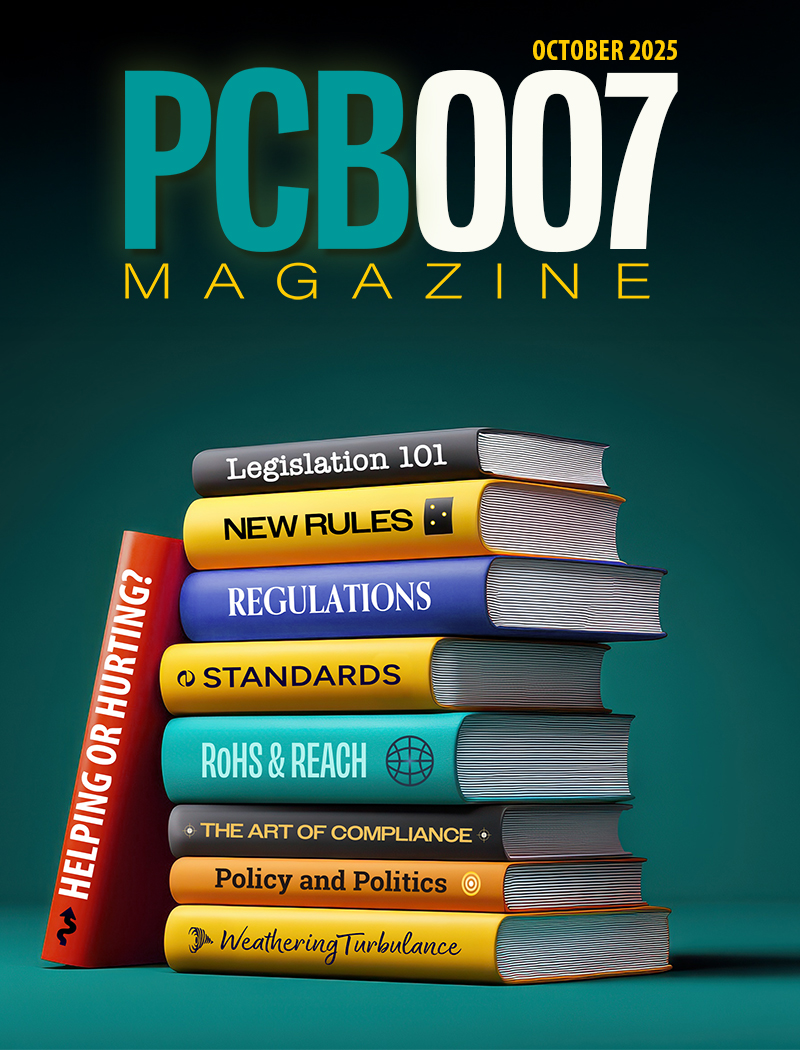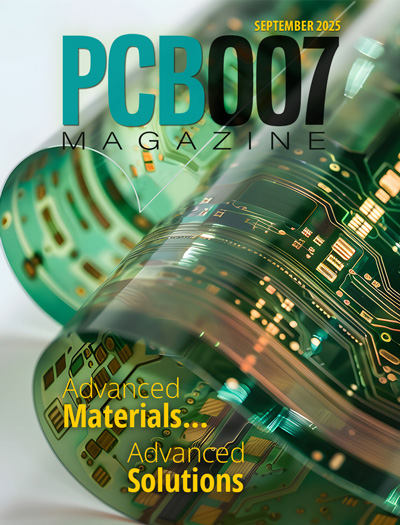-

-
News
News Highlights
- Books
Featured Books
- pcb007 Magazine
Latest Issues
Current Issue
Thank you, Columnists
This month, we give thanks to our columnists—the brilliant minds who share their expertise, experiences, and passion for the PCB industry. Meet the people behind the pages, learn what drives them, and discover their personal stories.

The Legislative Outlook: Helping or Hurting?
This month, we examine the rules and laws shaping the current global business landscape and how these factors may open some doors but may also complicate business operations, making profitability more challenging.

Advancing the Advanced Materials Discussion
Moore’s Law is no more, and the advanced material solutions to grapple with this reality are surprising, stunning, and perhaps a bit daunting. Buckle up for a dive into advanced materials and a glimpse into the next chapters of electronics manufacturing.
- Articles
- Columns
- Links
- Media kit
||| MENU - pcb007 Magazine
Better Together: How HDP User Group Showcases the Industry’s Best Side
June 21, 2017 | Barry Matties, I-Connect007Estimated reading time: 17 minutes
The High-Density Packaging User Group International Inc. (HDP User Group, or HDPUG) is a non-profit trade organization comprised of members from top companies in the electronics industry, from materials suppliers and manufacturers, to OEMs and end users. Key activities include collaborating on issues facing multiple industries and bringing people together on projects who might not have met otherwise. Barry Matties met HDPUG’s European representative and project facilitator Alun Morgan at the recent EIPC Summer Conference to learn more about the group and current projects.
Barry Matties: Alun, let’s talk about the HDP User Group. Would you mind sharing a quick overview of what the group is all about for our readers?
Alun Morgan: HDP User Group was formed 26 years ago. It's a research and development consortium comprised of members from some of the largest companies in our industry such as Oracle, Cisco, and IBM—many of the big companies who try to share information on common problems. For example, if one industry has an issue with lead-free materials coming around, another one has maybe the same issue. Rather than everybody solve the same issue themselves, we group our resources, and we can save costs. So the whole drive really is to save costs for the electronics industry in order to solve common problems or common issues.
We have nearly 30 projects running now and over 50 member companies. We meet four times a year, twice in North America, once in Europe, once in Asia. We look for new projects, and we carry our projects through to conclusion. Project life cycle varies. Some can be over in a matter of months and others could be a year or even multiple years. Many projects run over multiple phases. I run a few of them now on materials and reliability; we've tested more than 65 materials now in five phases. So with the new materials, we apply common methodology to testing them so we can compare over years how the performance is. Rather than companies having to test new materials, we do it as a group, and we share the data amongst the members so they can do at least a first level screening of new materials and know where they are.
Matties: How do you pick the projects?
Morgan: It's entirely member-driven. We go to the members and say, "What issues are affecting you?" Every meeting we have a call. We go around the room. People say, "Oh yeah, I've got an issue with this, or with that." And we select entirely on the member input.
Matties: Do you see recurring themes from year to year?
Morgan: Yes, we do. We get multiple phases, that's for sure. You can imagine that the lead-free change made a big impact on the industry, so we have a lot of projects on lead-free. We have a range of members. We have members who have to change straight away and members who have exemptions, for example, the military sector. The military and aerospace industries didn't need to go there yet, but of course they are having to go there at some stage, so we had some multiple phase process with them. We tested these things for commercial applications. Now we're looking at much more rigorous testing for military and aerospace applications.
Matties: So when you take a project on in the User Group, is this a project that you take on individually as a company?
Morgan: The HDP User Group appoint a facilitator whose job it is to manage the process of the project. The projects start with an idea. So someone says, "I've got an idea." And then we try to form a group around that. If we can get a group of a few people, half a dozen or so, interested in the project, then we'll have a kickoff call to discuss it. From there we go into define what the project will do—what are the goals of the project? What are the objectives? And how are we going to achieve that? Are we going to build some test vehicles? Are we going to do some initial research or what are we going to do? We move from that to the implementation phase when we actually do the work that we've planned out. And then that's how the projects conclude. The timescales can be varied. Ideas can last for weeks or they can last for months. Definition is usually relatively straightforward. Implementation, again, can be a long time. Some testing takes months.
Matties: It also depends on the participants’ own workload as well? It's still voluntary, so even though they're members, they're volunteers?
Morgan: Every project has a lead for the project. That is from one of the membership. So there's a facilitator who is staff for HDP, and there's a project leader from our membership base. The member basically leads the project. The facilitator does the organizing, the administration, makes sure things arrive on time, and gets resources that are needed as well. Sometimes resources have to be purchased. Sometimes the members offer them, so we generally have most resources given by the membership, but occasionally we have to buy some special components. There might be something we need to do and we take over that side of the work so the project team can focus on the technology and the technical aspects of the project. We take care of the administration.
Matties: You said that you have 30-some projects going. You meet four times a year. I'm assuming that there are a lot of project team meetings that are happening every day.
Morgan: Absolutely. We have them all the time. Every day. A typical cycle would be between two and four weeks for a conference call on a project. It depends on the stage we're at. Sometimes, when we go into testing, there might be a long time where there's nothing really happening. And then when the data starts to arrive we have a lot of calls, because a lot of it is failure analysis and data analysis. So they go that way, but yes, there are calls every single day. We use WebEx for our meetings as well, so you don't have to attend the meeting—you can attend remotely. We had a meeting just last week in Scotland, at Oracle in Linlithgow. We had a number of project leaders call in from Asia and North America. It's just like they're in the room. We just carry on as if they were there.
Page 1 of 3
Testimonial
"In a year when every marketing dollar mattered, I chose to keep I-Connect007 in our 2025 plan. Their commitment to high-quality, insightful content aligns with Koh Young’s values and helps readers navigate a changing industry. "
Brent Fischthal - Koh YoungSuggested Items
Indium Experts to Present on Power Electronics at productronica 2025
11/14/2025 | Indium CorporationAs one of the leading materials providers to the power electronics assembly and e-Mobility industries, Indium Corporation® experts will share their technical insight and knowledge on a variety of industry-related topics during Productronica, November 18-21, in Munich, Germany.
ESCATEC Installs Third Wave Soldering Machine in Penang to Meet Growing Demand
11/14/2025 | ESCATECESCATEC’s business unit in Penang, ESCATEC Electronics Sdn Bhd (EEM), recently welcomed the installation of an advanced Ersa POWERFLOW ULTRA wave soldering system, strengthening its capabilities and production capacity for customers bringing complex high-tech products to market.
Mycronic Unveils BA 01 Small Dot Ejector for Next-Generation Precision Jet Printing
11/12/2025 | MycronicMycronic’s BA 01 small dot ejector, delivers unmatched precision in solder paste jet printing for advanced PCB designs.
Indium is Electrifying the Future with Advanced Materials Solutions at productronica
11/11/2025 | Indium CorporationAs one of the leading providers in advanced materials solutions for power device packaging and materials for the electronics assembly and solder industries, Indium Corporation® is proud to feature its lineup of high-reliability products at Productronica, taking place November 18-21, in Munich, Germany.
KOKI to Host Technical Webinar on Dewetting Defects in SMT Soldering
11/11/2025 | KOKIKOKI, a global leader in advanced soldering materials and process solutions, announced its upcoming technical webinar, “Understanding and Preventing Dewetting Defects in SMT Soldering.”


